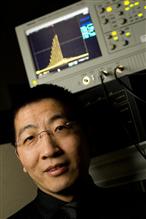Oct 17 2012
Light might one day be used to cool the materials through which it passes, instead of heating them, thanks to a breakthrough by engineers at Lehigh and Johns Hopkins Universities.
 Laser cooling, says Yujie Ding, would improve the utility of gallium-nitride, the most important semiconducting material after silicon.
Laser cooling, says Yujie Ding, would improve the utility of gallium-nitride, the most important semiconducting material after silicon.
The discovery, says Yujie Ding, professor of electrical and computer engineering at Lehigh, could lead to smaller, lighter and cheaper communication devices with faster switching times, increased output and higher operating voltages.
Ding and Jacob B. Khurgin, professor of electrical and computer engineering at Johns Hopkins, have achieved the most favorable ratio to date between opposing types of light-scattering phenomena that occur in semiconducting materials.
They published their results recently in Laser and Photonics Review in an invited article titled “From anti-Stokes photoluminescence to resonant Raman scattering in GaN single crystals and GaN-based heterostructures.”
Photons—units of light energy—typically maintain the same kinetic energy and wavelength when they exit a material as they do when they strike it. Raman scattering, named for Sir Chandrasekhara Venkata Raman, the 1930 Nobel Prize winner in physics, refers to the small fraction of scattered photons whose kinetic energy and wavelength, or frequency, differ from those of incident photons.
When this frequency is lower, it is called Stokes scattering, for Sir George Stokes, the 19th-century British physicist and mathematician. When it is higher, it is called anti-Stokes scattering.
The ratio of the occurrence of Stokes to anti-Stokes scattering, says Ding, is typically 35:1. Scientists would like to reduce this to 1:1, at which point a material neither heats nor cools when struck by light, and even further, when, with more anti-Stokes than Stokes scattering, a material imparts its energy, and thus its heat, to the light passing through it.
Ding and Khurgin, working with gallium-nitride (GaN), have succeeded in reducing the ratio of Stokes to anti-Stokes to 2:1. GaN, considered the most important semiconducting material since silicon, is used in light-emitting diodes (LEDs) and laser diodes. Other possible applications include high-frequency, high-power transistors that can operate at high temperatures, solar cell arrays for satellites, biochemical sensors and, because of GaN’s relative biocompatibility, electronic implants in humans.
Laser cooling achieved with GaN could also enable scientists to observe novel quantum effects and could make the high-electron mobility transistors (HEMTs) used in satellites more resistant to damaging ultraviolet rays.
“We are the only group to minimize the Stokes-anti-Stokes ratio from 35:1 to 2:1 at room temperature,” says Ding. “We have accomplished this by exploiting the different resonance behaviors of Stokes and anti-Stokes scattering.”
Researchers now achieve laser cooling, says Ding, by adding a dopant to the lattices of certain crystalline materials. But the portion of the lattice that actually cools represents only a tiny fraction of the entire lattice. If the right Stokes-anti-Stokes ratio can be achieved, every atom in the GaN lattice would cool and contribute to the cooling effect.
Ding and Khurgin plan next to build an optical resonator.
“We are still puzzled by the fundamental limit to the Stokes-anti-Stokes ratio and by the feasibility of reaching a ratio of 1 or less,” says Ding.
“We want to see, experimentally, how an optical resonator affects this ratio. We have already done the theoretical work for this. We want to conduct experiments inside a nanowire or other nanostructure to show how this ratio is affected by the structure.”
Lehigh Ph.D. candidates Guan Sun and Ruolin Chen are conducting experiments under Ding’s supervision.
Ding is a fellow of the Optical Society of America, as is Khurgin. Their research has been supported by the National Science Foundation and the Defense Advanced Research Projects Agency (DARPA).